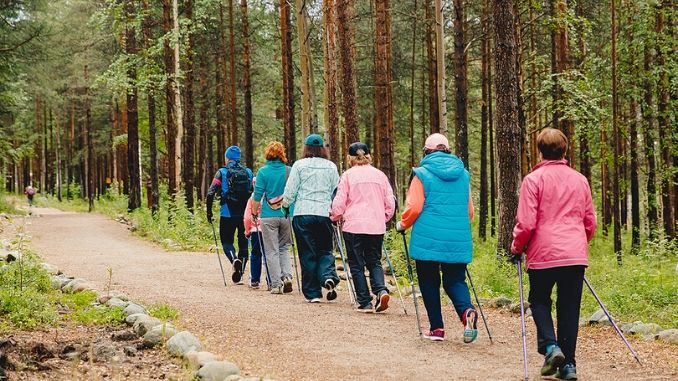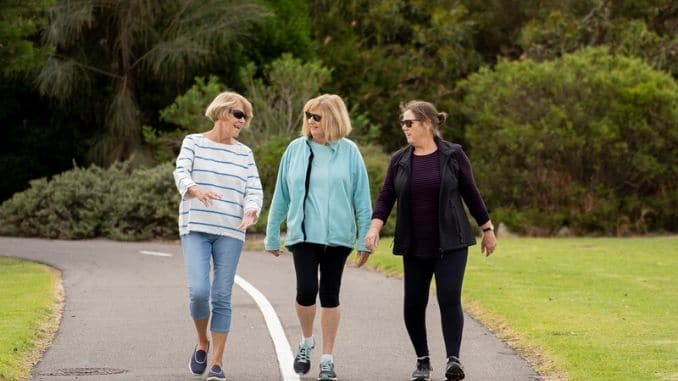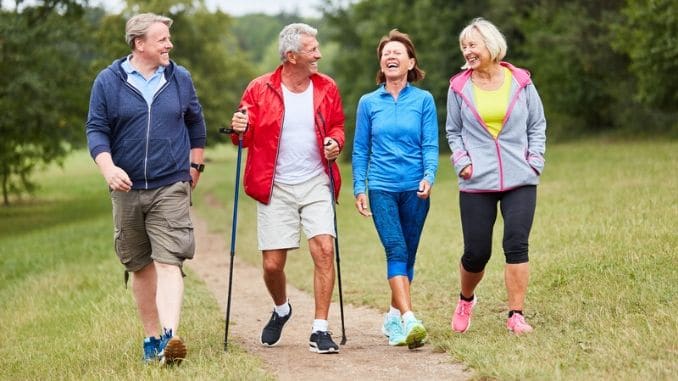
Do you have time to exercise?
It’s common for people to say they don’t have it. We’re all leading busy lives these days, and many of us struggle to find that extra half-hour or hour to work out.
But according to a recent survey of over 32,000 Americans, we could be fooling ourselves. Results showed that in general, people have more than five hours of leisure time per day, with men typically having more time than women.
Yet less than 7 percent of that time was spent doing physical activity. Instead, respondents spent most of their free time watching television or using their smartphones or other devices.
However, your time may line up against this survey. Studies show that if you use even 20 minutes of your time to simply take a walk, you could experience these 10 benefits and more.
1. Relieve Stress
If you spend too much time stressed out, you could be shortening your life. Researchers from Oregon State University found that men who experience persistently moderate or high levels of stressful life events over a number of years have a 50 percent higher mortality rate than those who experience less stressful events.
A later study of over 118,000 men and women found that the more stress people experienced, the higher their risk of mortality. Yet a simple 20-minute walk—particularly if you go to a park or other natural area—can help counteract the effects of stress.
Researchers from the University of Michigan found that just a 20-minute walk in nature—without using a phone or engaging in social media—resulted in lower levels of the stress hormone cortisol.
2. Enjoy Longer Life
How’s this for impact—a 20-minute walk each day could prolong your life. In a 2015 study, researchers from the University of Cambridge looked at data from over 334,000 Europeans with an average age of 50.
They found that those who engaged in just a brisk 20-minute walk daily were 16 to 30 percent less likely to die prematurely than people who didn’t exercise. The small amount of activity had benefits for both those who were at a healthy weight and those who were obese.
Lead author, Ulf Ekelund, stated in a press release: “This is a simple message: just a small amount of physical activity each day could have substantial health benefits….”
3. Reduce Your Risk of Depression
If you’re at risk for depression, embrace a daily 20-minute walk. According to a 2018 study, just 20 minutes a day could cut your risk of developing depression by one-third.
Scientists analyzed the results from 49 studies involving over 266,000 people and found that those who followed this recommendation were 31 percent less likely to develop depression over the 7.5-year research period compared to those who didn’t.
Other studies echo these findings, showing that physical activity plays an important role in reducing risk for depression, and can also reduce symptoms of depression once you have it.
4. Improve Your Thinking
A poor night’s sleep, heavy lunch, or stressful day can reduce your brain’s ability to focus and make good decisions. Take a 20-minute walk and you’ll likely fix the problem and feel much sharper as a result.
Researchers examined the relationship between walking, cognitive, and academic skills in a 2018 study. They required students from elementary, middle, high school, and college to walk for just 10 minutes prior to completing certain problem-solving tasks. Results showed that walking had a significant positive effect on performance in all age groups.
Walking can help older people regain mental acuity too. In a study published in Neurology, researchers observed 160 adults with high blood pressure or other risks for cardiovascular disease who never exercised and were already experiencing cognitive deficits like having difficulty making decisions, remembering, or concentrating.
The scientists divided the participants into four groups for a six-month study:
- Group 1: Started the DASH diet but didn’t change their exercise habits.
- Group 2: Performed non-strenuous exercise—35 minutes of walking or stationary cycling.
- Group 3: Followed the DASH diet and exercised three times a week.
- Group 4: Control group—made no changes.
After 6 months, results showed that the group who only exercised experienced significantly greater improvements in their cognitive thinking skills than the group that didn’t exercise. The group that followed the diet only didn’t show a significant improvement, but the one that combined diet and exercise saw the greatest benefit.
5. Boost Your Mood
Feeling irritable? Go take a quick walk. In a study from psychologists at Iowa State University, walking for just 12 minutes helped powerfully lift the mood.
The researchers conducted three experiments:
- In the first, they had one group of college students take a walk across campus buildings, while the other watched a video or browsed through videos. Those who walked reported feelings of self-assurance, joy, and vigor, while those who watched videos or browsed photos reported reductions in both mood and attentiveness.
- In the second, students completed a walking tour and then wrote an essay. Even knowing they had to write the essay, the students reported that the walk boosted their mood.
- In the third study, students walked on a treadmill, and still enjoyed mood-boosting results.
Other studies have shown similar results—just a short walk improves mood, no matter where you do it.
6. Reduce Risk of Heart Failure
The Centers for Disease Control and Prevention (CDC) states that about 5.7 million adults in the United States have heart failure. About half of those that develop heart failure die within 5 years of diagnosis.
You may be able to avoid this fate with a daily 20-minute walk. In a 2015 study involving over 33,000 people, researchers from Stockholm found that the first incidence of heart failure was later for those who actively walked or bicycled 20 minutes each day. Specifically, walking or cycling for just 20 minutes a day was associated with a 21 percent lower risk.
7. Reduce Risk of Type 2 Diabetes, While Improving Blood Sugar Control
The CDC states that over 30 million Americans have diabetes (about 1 in 10), and 90-95 percent of them have type 2 diabetes, which most typically develops after the age of 45.
The American Diabetes Association (ADA) states that of those with diabetes, 23.1 million were diagnosed, but the rest were undiagnosed and unaware of their condition. Meanwhile, 1.5 million Americans are diagnosed with the disease every year.
Studies from the Norwegian School of Sport Sciences and the University of Oslo reveal that even a short walk is enough to prevent a rise in blood sugar considerably—often as much as medicines designed to curb high blood sugar levels.
It’s natural to experience a rise in blood sugar after a meal, but frequent instances of elevated blood sugar levels can increase the risk of type 2 diabetes and cardiovascular diseases. Short walks after meals can help you avoid sugar highs. Even an easy stroll giving a pulse just barely above normal resting pulse rate prevented large increases in blood sugar levels.
This can be helpful in people who have already been diagnosed with type 2 diabetes, too. In a 2017 study, researchers found that post-meal exercise was more effective than just a once-a-day exercise for blood sugar control.
8. Increase Energy
When your energy lags in the afternoon, instead of reaching for that high-sugar soda, try taking a short walk.
Researchers at the University of Georgia found that healthy adults who engaged in as little as 20 minutes of low-to-moderate aerobic exercise (like walking) three days a week for six consecutive weeks reported an increase in energy levels and a reduction in feelings of fatigue.
The scientists split participants into two groups:
- Group 1: Called the “moderate-intensity” group, performed exercise comparable to a fast-paced walk up hills.
- Group 2: Called the “low-intensity” group, performed exercise equivalent to a leisurely walk.
Both groups experienced a 20 percent increase in energy levels with the low-intensity group reporting a 65 percent drop in fatigue and the moderate-intensity group reporting a 45 percent drop.
Researchers theorized that the moderate-intensity group didn’t experience as high a result because they were not exercising prior to the start of the study, so the moderate level of exercise left them more drained.
9. Help You Exercise More
Start walking today, and you may find it easier to walk tomorrow and the next day too. On top of that, you may start walking for longer periods of time, which is even better for your health and has been linked to reduced blood pressure and weight loss.
So, if you’re someone who’s been struggling to fit exercise into your life, start with just a 10-minute walk. In a 2011 study, researchers found that this was enough to initiate a gradually increasing amount of exercise per day.
In an 8-week trial, 60 inactive women were randomly assigned to one of 3 groups:
- Group 1: Control group.
- Group 2: Took a 30-minute walk once a day 5 days a week.
- Group 3: Took three short 10-minute bouts of walking a day.
The scientists tested the participants’ blood pressure, heart rate, body mass index (BMI), and hip and waist circumferences.
Results showed that both walking groups increased their physical activity compared to controls. In other words, this simple walking program helped both groups increase their daily physical activity.
So, start with 10 minutes, then see if you can lengthen your time so that you’re getting in at least one 30-minute walk per day. The study results showed that those walking for 30 minutes walked at a higher intensity than the short-bout groups, and also experienced significant decreases in hip circumference.
10. Boost Your Creativity
Stuck on a work or school project? Not sure what to do with your living room design? If you feel like you’re in a creative rut, go take a short walk.
Researchers from Stanford found that walking boosts creative inspiration. Over the course of four experiments involving 176 college students and other adults, the scientists had the participants walk on a treadmill or outdoors, or simply sit facing a blank wall or sit outdoors. After each experiment, the participants completed creativity tests.
Results showed that the overwhelming majority of the participants in all experiments were more creative while walking than while sitting. More specifically, their creative output increased by an average of 60 percent while walking. The effects continued for a short time after the participants stopped walking, too.
So, get up and get moving! You’re never too old to get started, and you don’t need to over-exert yourself in order to take full advantage of the benefits that a daily walk can provide. Walking is also a great opportunity to catch up with your spouse or friends, so combine your daily exercise with a nice social opportunity. Just 20 minutes each day can make a big difference!
Eliminate your knee pain without surgery, injections, or dangerous medications. For more information, try our Patellofemoral Pain Syndrome program.










